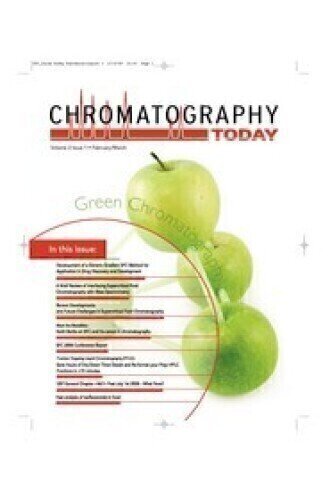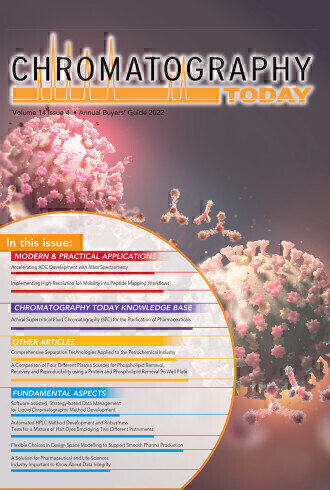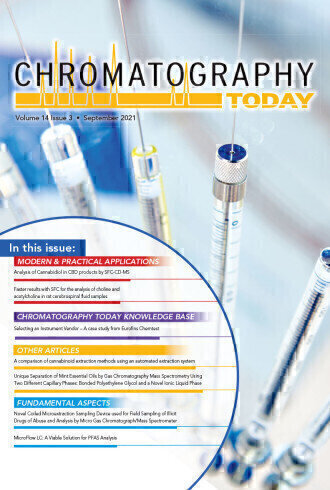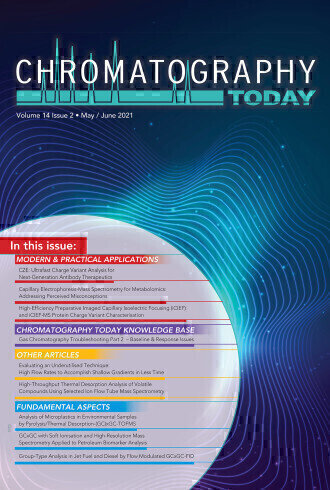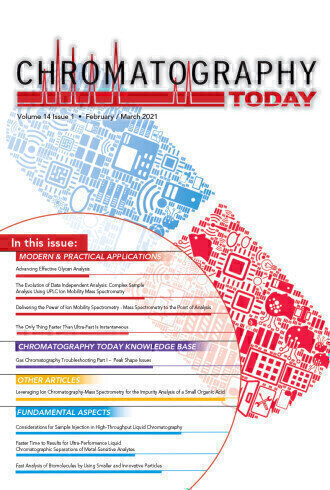Volume 2 Issue 1
Welcome to the fifth edition of Chromatography Today. For this issue the focus is primarily on the area of Supercritical Fluid Chromatography (SFC) alongside a number of other complementary separation science articles. SFC has its origins in a paper on “high pressure gas chromatography above critical temperatures” [1] in 1962. More recently in the 1980s and 1990s, considerable effort was invested on designing instrumentation capable of harnessing supercritical fluids as mobile phases for the separation of diverse ranges of compound classes. However, some might say that like capillary electrophoresis, SFC has largely failed to deliver on its early promise with instrument hardware issues, particularly the failure of back pressure regulators required to keep the (typically) carbon dioxide mobile phase in a pressurised state being cited as the main problem.
In theory, SFC offers some significant advantages over HPLC and GC. The two main advantages often noted are:-
• The technique being capable of generating peak efficiencies bordering on those observed in GC
• The possibility of running separations atmuch higher linear flow rates than HPLC resulting fromthe significantly lower back pressures generated by this technique compared to HPLC.
However, there are a number of additional advantages of this technique including:-
• The polarity of themobile phase can be readily varied with low volumes of organicmodifiers to allow analysis of compounds ranging fromhighly polar to highly hydrophobic.
• Ease of sample preparation. As a rule of thumb, if a sample will dissolve in puremethanol, it will be amenable to analysis by SFC.
• Applicability to preparative isolation work as a result of the nature of the volatile effluent in which the fractions are collected.
• High success rate for enantioseparation when the technique is applied to chiral analysis (chiral analysis will be the theme for an issue of Chromatography Today later this year)
• Large sections of SFC hardware are derived fromHPLC technology and it is therefore very easy for HPLC-savvy analysts to work with this technology quickly.
Perhaps worryingly for this field, competition in the formof instrumentation is not strong with only a fewmanufacturers producingmodules compatible with this technique or having the infrastructure to support an SFC customer base. With only a handful of companies involved, theremay also be the concern that innovationmay be stifled by lack of competition. In spite of these factors, SFC seems to be undergoing a re-emergence as a technique. Analysts are beginning to re-engage with its potential to help address complex separation challenges and helpmeet ever increasing regulatory demands for products. As well as articles on HPLC and GC, this edition of Chromatography Today will focus on the key theme of SFC by touching on recent developments in the technique, hyphenation of SFC withMS, SFC column technology and validation of SFCmethodology.We will also be reminded, amongst other things, of some of the early days of SFC through an interview with Professor Keith Bartle (new feature:Meet theMedallists), an early pioneer of SFC in the UK.
As an aside – youmay be aware that the world’s supply of acetonitrile is experiencing significant pressure both fromnatural disasters and global demand. Suppliers informus that there are a number of events that havemade global sourcing both limited and costly. These are unprecedented global demand, natural disasters preventingmanufacturing and distribution and feedstock shortages. Obviously acetonitrile is an important solvent in liquid chromatography, and we would be interested if you are experiencing issues with obtaining acetonitrile and whatmeasures youmay be putting in place to mitigate this issue. If there is enough opinion, we will report back in a future edition of Chromatography Today. We hope you find these articles useful for your work and are always happy to receive feedback on this or any of our previous editions. Finally, it would be remiss ofme to conclude withoutmentioning forthcoming Chromatographic Society events. Full details of our first twomeetings of the year, “Separation Science in the UK: State of the Nation” at Runcorn onMarch 18th
and “Advances in LC-MS and Related Hyphenated Techniques” at Sunderland onMay 13th/14th,may be seen on www.chromsoc.com
References
1. E. Klesper, A.H. Corwin and D. Turner, J. Org. Chem. 27 (1962) 700.
Previous Digital Editions
Digital Edition
Chromatography Today - Buyers' Guide 2022
October 2023
In This Edition Modern & Practical Applications - Accelerating ADC Development with Mass Spectrometry - Implementing High-Resolution Ion Mobility into Peptide Mapping Workflows Chromatogr...
View all digital editions
Events
Apr 28 2024 Montreal, Quebec, Canada
May 05 2024 Seville, Spain
May 15 2024 Birmingham, UK
May 19 2024 Brno, Czech Republic
May 21 2024 Lagos, Nigeria
